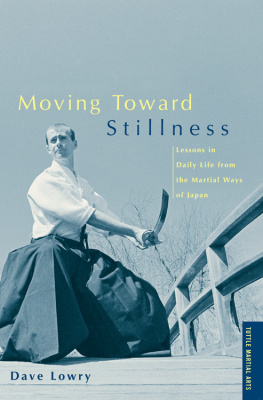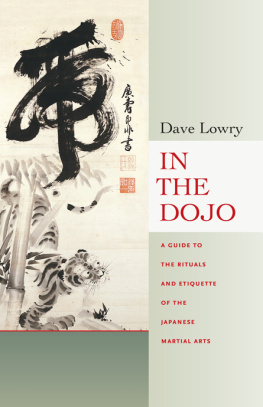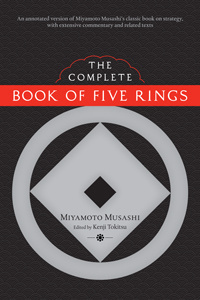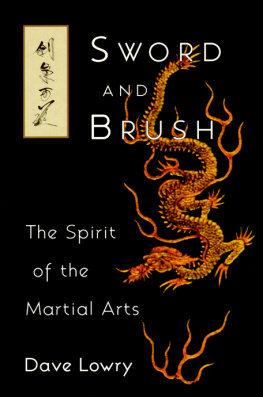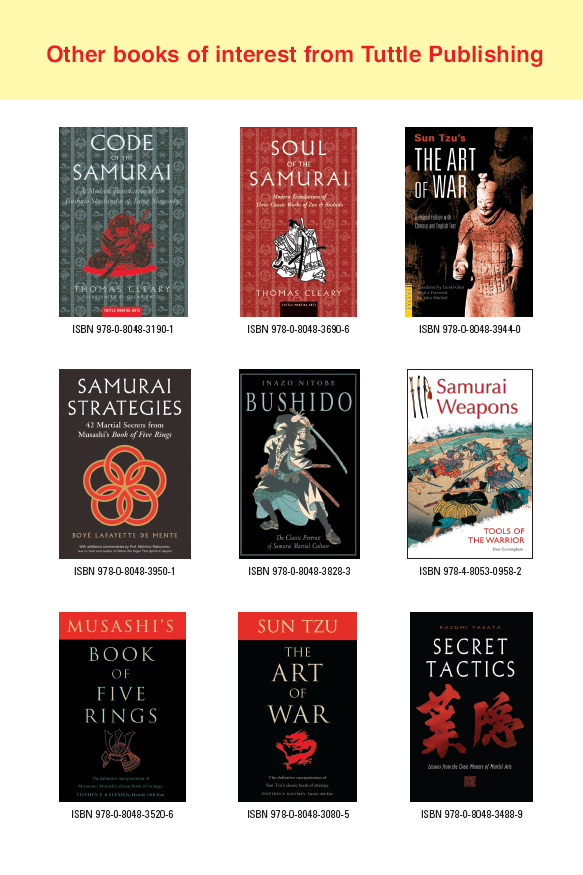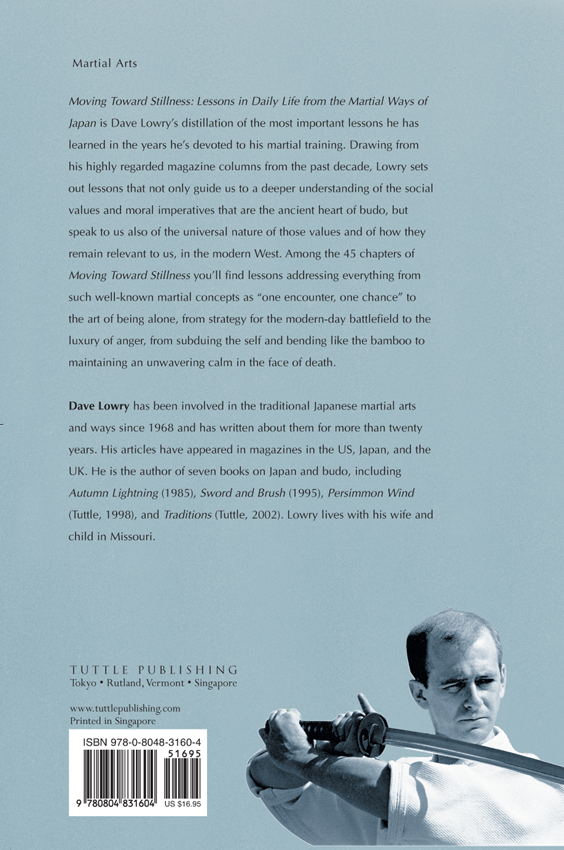Chapter One: Entering the Doorway
| Chapter One |  |
Entering the Doorway
"A man is judged by how he opens a door,
and a woman is judged by how she shuts it."
To understand the meaning behind this curious saying we must know something about doors and the architecture of premodern Japan. Unlike the hinged doors of Western-style buildings, Japanese doors slide back and forth along grooved wooden tracks in the floor. In some rooms, the door might be a small rectangle, providing an opening so tiny that one must virtually crawl through it on one's hands and knees. These little doors are called nijiri guchi ; they are a common feature in the traditional tea house used for the ritual of making and drinking tea, or chado . Part of the tea ceremony involves making a humble entrance to the house itself. Scooting through the small opening on ones hands and knees serves as a way of humbling oneself and deflating the ego. (Considering the size of some of the egos passing into them today, if we could install nijiri guchi in the doorways of the dojo , or martial arts training halls, to be found in this country, it would doubtless be the most wonderful architectural improvement imaginable for those structures.) Traditional Japanese buildings also have doors that span entire walls or are room partitions that can be slid back to double the size of a room. No matter what their size or shape, Japanese doors of all kinds are opened in the same way: you kneel at the crack of the door and push it open, then you come into the room by sliding forward on your knees.
This is quite a simplified description of entering a room, as any exponent of a truly classical Way or art of Japan will tell you. Sukisha well-bred peopleknow that you must use the hand nearest the door to open it a few inches ("the length of a forefinger," to be exact, according to one feudal school of etiquette), then you switch hands to slide it back the rest of the way. There are all kinds of manners to be observed in this simple action of opening a door and coming into a room if you are to observe the protocol of ancient Japan. The point is, to the Japanese of the feudal period, even an ordinary, everyday task like entering a room had a significance and a prescribed order that evolved about it. It is no exaggeration to say that when performed with the proper spirit and mental attitude this mundane action could assume the proportions of a kata , one of the formal movements that are the foundation for all the Japanese arts and Ways. And the meaning of the expression that a man is judged by how he opens a door and a woman by how she shuts it is found in that spirit and attitude.
Look at it this way: it would be very easy to make a flashy, imposing entrance through a Japanese style door. You could sling open the door along its track with a vigorous shove, banging it against the supporting frame with a dramatic thump! Remember, too, that people sit on the floor in a traditional Japanese home. If you come striding into the room standing up, you are going to tower over everyone sitting there. You will be imposing. You will have the attention of everyone in the room. Literally, everyone there would, indeed, be in the position of looking up to you. To many, this would, indeed, seem a most attractive way to "make an entrance," so they must wonder why it is that Japanese etiquette demands just the opposite.
The answer is that manners in Japan, a good many of them at least, have always been directed at maintaining and preserving social harmony. Getting along with the other fellow was important, and important, too, was the concept that the individual self was not so significant as the welfare of the group. (Of course, these motivations have guided the etiquette of most civilizations. In Japan, however, they were paramount. Rice, always the staple grain of the Japanese diet, is so labor-intensive to cultivate that communal work and living was a necessity. This led to patterns of settlement where people spent much of their lives close by others. In many ways, the etiquette of traditional Japan served as a lubricant against the inevitable social frictions of daily life.) The higher in the social order the individual, then, the more humble and self-effacing he often was in his conduct. The "classier" the person, the less he needed to display himself.
The individual who was secure in his social caste did not need to remind himself or others of his position constantly. When he came into a room, it was not necessary to use the entrance as an occasion for drawing attention to himself. He came in quietly, using first one hand and then the other to open the door, because that method allowed the door to be moved softly, with minimal noise. He entered using a sliding shuffle on his knees because that kept him at a level equal to others already in the room.
This is the meaning behind the saying that a man could be judged by how he entered a room. But why the distinction between men and women? Does the adage imply there was a different standard of manners between the sexes? Well, yes, to some degree. Women were often in subordinate positions in daily life in old Japan. If a group of men were in a room, it would likely be a woman who served food and drink and who would then leave. So a woman would be leaving a room more often, closing the door behind her while there were still people inside. Hence the distinction between the sexes in the expression. But that distinction can be misleading. In essence, gender is superfluous. What matters is the spirit and attitude with which one conducts him-or herself.
This spirit and attitude has pervaded Japanese culture, and since the budo are a product of that culture, it should hardly be surprising that such concepts are an integral part of the martial Ways as well. And doubtless that is why it is so disappointing and saddening to see so many people who presumably are serious about making the budo a meaningful part of their lives yet who so determinedly remain ignorant of this spirit and attitude or who, worse still, deliberately choose to disregard it. Whenever you see a martial arts "master" come strutting onto the dojo floor as if the world were fortunate to have him in it, or a competitor at a budo competition come prancing out of the square with his hands held triumphantly aloft, you are witness to such ignorance, such arrogant disregard for the traditions in which the budo were developed.
The skills of opening and closing a sliding Japanese door are a part of reishiki , "proper form," or "etiquette." The ability to move in a balanced and graceful way by sliding one's knees on the floor is a specific aspect of this form, this mastery of the self that allows us to get along with others and to present ourselves to the world in a respectful way. To the regret of those of us who have an interest in, a feel for the traditions of old Japan, these are skills and abilities that have largely disappeared in the modern world. Those who are still conversant with these traditions tend to be exponents of the classical arts, like the budo and tea ceremony, people willing to spend the time to learn methods that are in actual practice of limited value. Unless you are living in Japan, and even there nowadays, knowing how to open a sliding door and how to go in and out of it are not, to be sure, vital in day-to-day affairs. But still some manners, what D'Avenant called those "unwritten laws by which the people keep even kings in awe," have a way of transcending time and immediate circumstance. In any era, any culture, we are all judged by the little things we do. Things like entering and leaving a building. We who set out to follow the path set by the Japanese martial Ways are especially conscious of this, knowing that outer form is so often an expression of a deeper inner state. This should give you something to think about when you enter a room or close a door, whether you turn the knob or push the handle or slide the door along a track.

